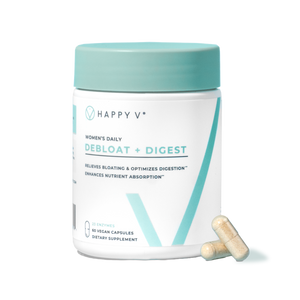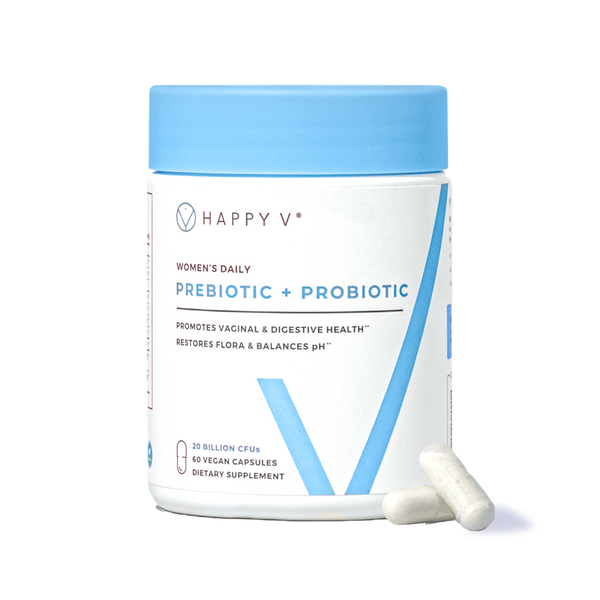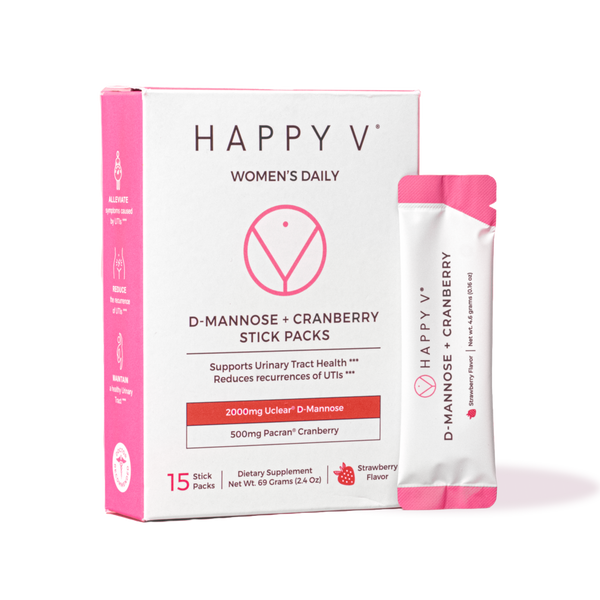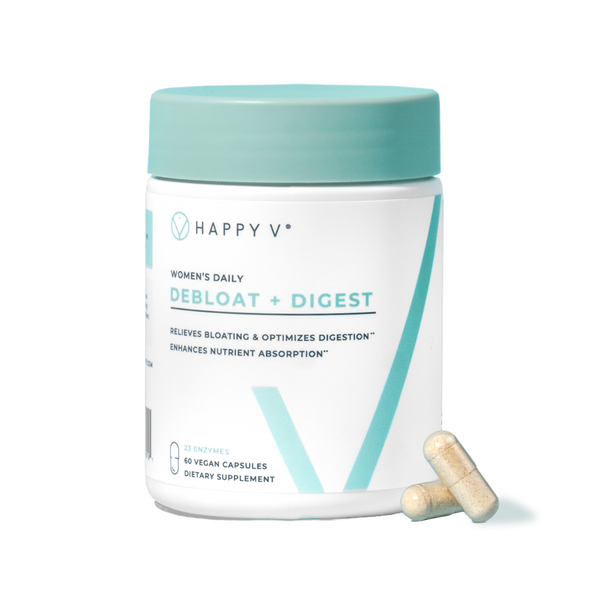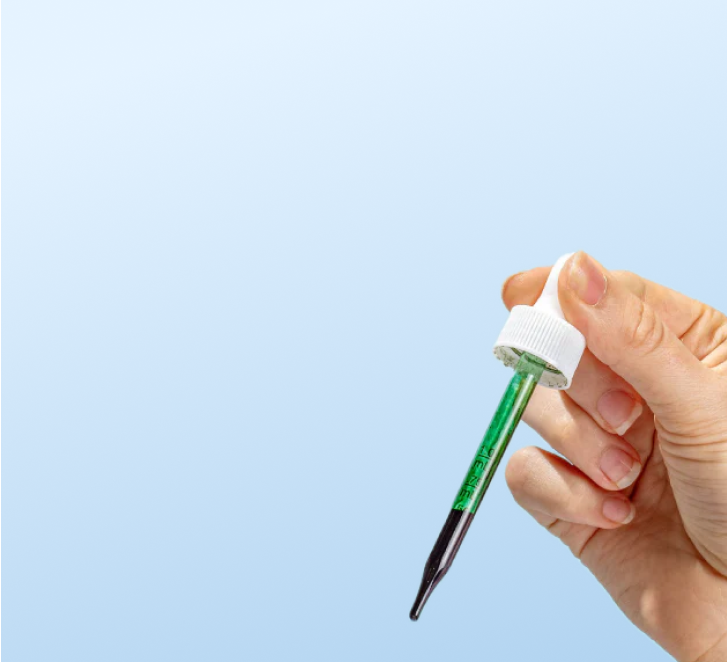- Fact Checked
- November 03, 2025
- 24 min read
Prevotella and Vaginal Health: What You Should Know About This Under-the-Radar Bacteria
Table of Contents
Table of Contents
When it comes to vaginal and gut health, Lactobacillus usually gets the spotlight—and for good reason! Lactobacillus is an important probiotic that keeps the gut and vagina working as they should1. But if you care about your overall wellness, there's another group of bacteria worth knowing about: Prevotella. These bacteria are part of your body’s natural microbiomes, but when they multiply too quickly or appear in the wrong place, they can contribute to infections, inflammation, and symptoms like recurring BV.2
In this post, we'll break down what Prevotella is, where it shows up in the human body, and what it means for your vaginal and whole-body health.
This post is for informational purposes only and does not constitute medical advice. See full disclaimer below.
What Is Prevotella?
Prevotella is a genus (or "family group") of bacteria made up of dozens of different bacterial species. These gram-negative, anaerobic bacteria are found in several parts of the body, including the vagina, mouth, gut, and lungs.
Some Prevotella species are relatively harmless commensal organisms3, while others can become disruptive pathogens, especially when they grow in places they don't belong or crowd out more protective bacteria like Lactobacillus.
The fascinating thing is that Prevotella diversity varies significantly between individuals, making each person's microbiome unique4!
A Quick Look Back: Where Did Prevotella Come From?
The name Prevotella was introduced in 19905, when scientists took a group of sugar-loving, bile-sensitive bacteria from the Bacteroides family and reclassified them into a new genus. The name honors André R. Prévot, a French microbiologist who specialized in anaerobic bacteria (or microbes that thrive in low-oxygen environments, like the vagina and gut).
One of the first bacterial species in this group was Prevotella melaninogenica, which was commonly found in the oral cavity6. At the time, scientists sorted species based on how they behaved in the lab, such as whether or not they produced pigment (some colonies actually turn brown or black when grown on blood agar plates!). This gave them a basic way to distinguish between "pigmented" and "non-pigmented" strains at the species level.
How Scientists Classify Prevotella (Then vs. Now)
In the past, researchers used several hands-on methods to classify Prevotella, including:
- G+C content (the percentage of guanine and cytosine in the bacteria's DNA)7
- DNA–DNA hybridization (comparing how well DNA strands from different species matched)8
- Multilocus enzyme electrophoresis (analyzing enzymes produced by different strains)9
- Colony shape, growth conditions, and pigment production
Today, those methods have been largely replaced—or supported—by modern genetic testing that gives us incredible insights:
- 16S rRNA sequencing is like taking a fingerprint of a microbe's identity10
- Whole-genome sequencing allows scientists to compare the entire genome blueprint of one species against another
- Metagenomic analysis provides insights into entire microbial communities and helps us understand Prevotella diversity
Thanks to powerful genetic tools, scientists have discovered that the Prevotella genus is incredibly diverse. For example, the size of its genomes (its complete sets of DNA) can range from 2.4 to 4.3 million base pairs, and its G+C content (a way of measuring DNA composition) can vary from 36% to 56%. That’s a big difference for bacteria in the same family.
This wide genomic diversity means that different Prevotella species can live in very different parts of the body and do different things—some helpful, some harmful. Understanding these differences helps researchers figure out which species might be involved in conditions like bacterial vaginosis, gut inflammation, or even lung infections.
Meet the Key Species in the Prevotella Family
Here's a quick overview of some of the most well-known Prevotella species, where they live, and what they're best known for:
|
Specis |
Where It's Found |
Why It Matters |
|
P. Bivia |
Vagina |
Common in bacterial vaginosis (BV); forms protective biofilms with Gardnerella11 |
|
P. disiens |
Vagina, oral cavity |
Often found in imbalanced vaginal microbiomes (especially CST-IV) |
|
P. melaninogenica |
Mouth, lungs |
Linked to chronic respiratory conditions like COPD and periodontitis |
|
P. copri |
Gut |
Associated with high-fiber diets and linked to IBD and inflammation |
|
P. pallens, P. oris |
Oral cavity |
Found in dental plaque; involved in gum and periodontal disease |
|
P. jejuni |
Small intestine |
Found in some individuals with celiac disease |
|
P. pleuritidis |
Lungs |
Detected in pleural fluid and associated with lung abscesses |
The Science of Prevotella Is Still Evolving
Even though Prevotella was officially recognized in 1990, scientists are still learning about this diverse group, and honestly, it's pretty exciting!
That's because taxonomy, or the system we use to name and group bacteria, isn't fixed. It evolves as technology and knowledge improve.
Using powerful genetic tools like whole-genome sequencing and metagenomic approaches, scientists now recognize that:
- Some bacterial species originally labeled Prevotella were genetically distinct enough to move into new genera (for example, P. tannerae is now Alloprevotella tannerae)
- Others, like P. heparinolytica and P. zoogleoformans, may be removed from the Prevotella genus entirely because they're so genetically distant
- Some species are described from just one or two isolates, which makes their classification tentative and open to revision
- The relative abundance of Prevotella varies significantly across different human populations and enterotypes
-
Prevotella diversity is influenced by geography, diet, and lifestyle factors
The result? The Prevotella family tree is constantly being pruned, reshaped, and expanded. And while this ongoing change might seem confusing, it's actually a good thing! It means science is getting better at understanding which bacteria are truly distinct and what they're doing in the body.
Why It Matters
Understanding Prevotella isn't just a microbiology trivia game. It has real implications for human health and wellness. Knowing which species live where (and what they're capable of) helps researchers and doctors better understand conditions like:
-
Bacterial vaginosis (BV)
- Chronic gut inflammation and IBD
- Celiac disease, reflux, and esophageal disorders
- Respiratory infections like pneumonia, COPD, and asthma
- Even autoimmune conditions like rheumatoid arthritis, where gut microbes including certain Prevotella species may play a role
And for you? It's a reminder that knowing your microbiome is part of knowing your body! The more we understand these tiny organisms and their correlation with disease, the better we can care for our vaginal, gut, and full-body health.
How Prevotella Affects Vaginal Health
When everything is in balance, your vaginal microbiome is mostly made up of protective bacteria like Lactobacillus—and we're here for it! But when those good bacteria decrease due to stress, antibiotics, hormones, or other changes, Prevotella can step in and stir up trouble.
Here's how Prevotella contributes to vaginal imbalances, especially conditions like bacterial vaginosis (BV):
It Weakens Your Natural Defenses
Prevotella produces enzymes that break down mucins12, which are the slippery, gel-like proteins that help form a protective mucosa barrier on your vaginal walls. Think of mucins as the epithelial lining that keeps harmful pathogens from sticking around.
When Prevotella breaks them down, it leaves your vaginal lining more exposed and more vulnerable to dysbiosis or imbalance13. This process affects the delicate mucosa that lines your vaginal tract, making it less effective at protecting you.
It Promotes Inflammation
Prevotella also produces a molecule called lipopolysaccharide (LPS)14. This molecule can activate your immune system and spark inflammation, even if there isn't a full-blown infection.
This low-level immune response may be part of why you feel irritation, discomfort, or see an increase in discharge with Prevotella overgrowth. The correlation between Prevotella abundance and inflammatory biomarkers is well-documented in research, and understanding this connection is crucial for both gynecology and immunology.
It Works with Other Bacteria to Form Biofilms
One of Prevotella's sneakiest moves is teaming up with Gardnerella (the #1 cause of BV) and other anaerobic bacteria to form biofilms. These are sticky, slimy layers that cling to your vaginal walls and protect harmful bacterial communities from antibiotics or the immune system. Think of it like a microscopic hideout. That's one reason BV can be so hard to treat and often comes back.
It May Raise Your Risk for Infections and Complications
When the vaginal barrier is weakened and inflammation is high, it becomes easier for viruses and other pathogens to take hold15.
Studies have linked Prevotella overgrowth to higher risk for sexually transmitted infections (like chlamydia and HIV), pelvic inflammatory disease (PID), and even complications during pregnancy16. This demonstrates how the abundance of Prevotella can serve as a biomarker for overall vaginal health status.
Bottom line: Prevotella isn't necessarily dangerous on its own, but when it grows too much—or joins forces with other troublemakers—it can tip your vaginal microbiome into chaos. And it tends to overgrow when protective Lactobacillus levels are low, disrupting the delicate homeostasis of the vaginal microbial community.
Symptoms of Prevotella Overgrowth
Prevotella overgrowth doesn't usually cause symptoms all by itself, but it's often part of the bigger bacterial imbalance behind BV.
Here's what you might notice if your Prevotella overgrowth has led to a BV infection:
- Thin, grayish vaginal discharge17
- A fishy or unpleasant odor (often worse after sex)18
- Vaginal itching or irritation
- A vaginal pH higher than 4.5
- BV symptoms that keep coming back, even after treatment
So while Prevotella may not be the only player, it's often part of the cast when the vaginal microbiome is out of balance and dysbiosis occurs.
How Do You Test for Prevotella Overgrowth?
You can't see or feel Prevotella directly, but healthcare providers have amazing tools to detect it or figure out whether your vaginal microbiome might be off.
If you've had repeat BV, ongoing discharge, or irritation that doesn't go away, here's how a provider might investigate whether Prevotella is involved:
Vaginal Swab Testing
The most accurate way to find out what's living in your vaginal microbiome is a simple vaginal swab. With a swab, your provider gently collects a sample from the vaginal wall (which is quick and usually painless), then sends it to a lab for testing.
Tests may include:
-
PCR (Polymerase Chain Reaction): This test detects the DNA of Prevotella and other bacterial species with high sensitivity, even at the species level19.
-
16S rRNA Sequencing: This advanced test maps out the full microbial community in your sample, showing which species are present, how abundant they are, and revealing Prevotella diversity20.
-
Metagenomic sequencing: This comprehensive approach analyzes the entire genetic material present, providing detailed insights into microbiome composition and species-level identification.
These tests are often offered through OB/GYN offices, fertility clinics, or specialty women's health labs and can identify specific Prevotella strains and their relative abundance.
Nugent Scoring
This is a more traditional method where a lab technician looks at your sample under a microscope and scores it based on the types of bacteria present. It won't call out Prevotella by name, but a high score typically indicates an overgrowth of anaerobic bacteria (like Prevotella) and low Lactobacillus.
Symptom + Treatment History
Your story matters, too! Even if tests don't specifically mention Prevotella, patterns in your symptoms can offer important clues as to your microbiome makeup. For example:
-
Vaginal odor or discharge that keeps returning
- Symptoms that come back soon after antibiotic treatment
- Multiple rounds of BV with short relief in between
In these cases, your provider may suspect that stubborn bacteria (possibly including Prevotella) are hanging on or hiding in a biofilm.
Pro Tip: Bring a symptom journal or treatment history to your OB/GYN visit. Noting when symptoms occur, what treatments you've tried, and what's helped (or hasn't) can guide better testing and care.
Beyond the Vagina: How Prevotella Affects Other Parts of the Body
While Prevotella is best known in women's health for its role in bacterial vaginosis, it's also gaining attention in other areas of research, including the gut microbiome and lungs. Here's what you should know about this fascinating microbe and its wider impact on your health.
Prevotella and Gut Health
Prevotella isn't just a passive presence in the gut microbiome—it's actually quite active! It can be a major player in gastrointestinal health and disease depending on how much of it is present21, which Prevotella species are involved, and your diet and lifestyle.
The human gut microbiota contains various enterotypes, with some populations showing high abundance of gut Prevotella while others are dominated by Bacteroides22. Understanding gut Prevotella and its role is crucial for digestive wellness.
How Prevotella Contributes to Gastrointestinal Diseases
Some Prevotella species are being recognized for their role in triggering or worsening GI conditions. They're not necessarily harmful on their own, but they can disrupt gut health in several ways:
Breaking down the gut's protective barrier: Gut Prevotella can degrade mucins, or the proteins that line and protect the gut, making it easier for harmful microbes and inflammatory molecules to pass through the gut wall and into the body. This affects the mucosa homeostasis and can compromise the epithelial barrier function, which is super important for digestive health.
Promoting inflammation: Many Prevotella species produce substances like lipopolysaccharides (LPS) that stimulate immune cells to release inflammatory chemicals, such as interleukin-1β. This can lead to or worsen gut inflammation and disrupt normal immune response patterns (an area where immunology research is making exciting discoveries).
Altering the microbiome: Prevotella can change the overall balance of gut microbes, crowding out helpful species and encouraging the growth of other microbes that promote inflammation. This microbial community modulation can have far-reaching effects on host health.
Species-Specific Associations with GI Conditions
Different Prevotella species have been linked to specific gastrointestinal diseases, and the research is fascinating:
Inflammatory Bowel Disease (IBD)
Prevotella copri and P. intermedia are often found in higher amounts in people with Crohn's disease and ulcerative colitis, especially during flare-ups.
Some research links P. copri to increased levels of Th17-related cytokines, which promote inflammation in the intestinal lining23. Overgrowth of Prevotella is also commonly associated with reduced diversity in the gut microbiome, a known sign of dysbiosis.
In some cases, elevated P. copri has been proposed as a possible biomarker for IBD, especially in people with genetic risks or high-carbohydrate, low-fat diets. A recent study showed that P. copri abundance correlates with disease severity in IBD patients, highlighting the importance of species-level analysis.
Celiac Disease
P. jejuni was first identified in the small intestine of a child with celiac disease24, and has since been found in duodenal tissue from patients with active disease. Higher levels of P. intermedia have also been found in people with untreated celiac disease, where it's been linked to increased intestinal permeability ("leaky gut") and inflammation. These species may worsen gluten-triggered immune reactions by affecting the gut lining and interacting with immune cells, especially in people with already-compromised gut microbiomes.
The correlation between these Prevotella species and celiac phenotypes suggests they may serve as potential biomarkers for disease monitoring.
Gastritis and GERD
P. melaninogenica and P. pallens are more commonly found in people with chronic gastritis and gastroesophageal reflux disease (GERD). These bacteria are usually part of the oral microbiome but can make their way into the stomach via saliva or small amounts of refluxed material.
Once in the stomach, they may worsen inflammation from stomach acid, increase oxidative stress, and potentially slow the healing of irritated stomach tissue. Some studies show that more of these species can be linked to more severe GERD symptoms and an increased risk of developing Barrett's esophagus.
Esophageal Disorders
Higher levels of P. melaninogenica, P. pallens, and P. oris have been found in people with Barrett's esophagus and early-stage esophageal cancer25. These species seem to push the esophageal microbiome toward a more inflammatory state, possibly by releasing LPS and disrupting immune signaling. This may worsen acid-related damage and contribute to epithelial metaplasia, a key step in the development of Barrett's.
Researchers are now studying these bacteria as possible non-invasive biomarkers for early detection of esophageal disease.
Digestive Tract Cancers
Several Prevotella species are linked to cancers in the upper digestive tract, including the esophagus and stomach. For instance, P. multiformis, P. nigrescens, and P. oris are often found in patients with gastric cancer. Shifts in Prevotella populations, like increased levels of unclassified Prevotella or changes in P. melaninogenica, have also been observed in Barrett's esophagus and esophageal cancer.
In some studies, high levels of Prevotella, especially when combined with bacteria like Streptococcus, are linked to poorer outcomes in esophageal squamous cell carcinoma and may influence cancer pathogenesis26.
Connection to Autoimmune Conditions
Emerging research suggests that certain gut microbes, including some Prevotella species, may play a role in autoimmune conditions like rheumatoid arthritis27. The connection between gut health and joint inflammation is an exciting area of immunology research that shows how interconnected our body systems really are!
How Oral Prevotella Reaches—and Affects—the Gut
The gut microbiome doesn't work in isolation. Every system in your body is connected.
Oral Prevotella species can travel to the gut when we swallow saliva (which we do—about 1.5 liters per day!). These bacteria can survive the acidic stomach and end up in the intestines. This means what happens in your mouth can influence your gut and vice versa, creating a complex host-microbe interaction network.
Lifestyle and Environmental Factors
Several outside factors shape how Prevotella behaves in your gut microbiome:
Diet: Diets high in dietary fiber and plant foods tend to support Prevotella, especially P. copri28, while Western diets favor different microbial communities. The abundance of Prevotella correlates strongly with carbohydrate and polysaccharide intake. A fiber-rich diet can promote beneficial Prevotella strains that help with glucose metabolism and support healthy gut microbes.
Smoking: Smoking may lower Prevotella in the upper gut; quitting only partially restores those levels.
Medications: Antibiotics and acid-reducing drugs can shift the microbiome, sometimes allowing Prevotella to either overgrow or decline, depending on the situation. Supplementation with prebiotics may help restore beneficial taxa29.
Why Prevotella Matters for GI Health
Having Prevotella in your gut is a mixed bag, but at the end of the day, it's all about balance.
Some species may offer metabolic benefits, but others are linked to inflammation, gut lining damage, and disease. Recent studies suggest that certain Prevotella strains may even be associated with obesity through their effects on glucose and carbohydrate metabolism. Knowing what's in your microbiome—and how your lifestyle affects it—can help you support your digestive health.
The bottom line: Prevotella plays a significant role in gut health and the human gut microbiome. Ongoing research may help us learn how to manage it better through diet, probiotics, and lifestyle changes to prevent or improve GI conditions. Understanding Prevotella diversity and species-level differences is key to personalized gut health approaches!
Prevotella and Respiratory Health
Prevotella doesn't just hang out in the gut or vagina; it's also a common resident in the mouth and respiratory tract. While many species are considered part of our normal commensal microbiome, recent research suggests Prevotella may play an active role in both healthy and diseased lungs. Pretty amazing how connected everything is!
How Prevotella Contributes to Respiratory Diseases
Prevotella usually doesn't cause respiratory disease on its own, but it can work alongside other microbes and impact inflammation, symptoms, and treatment through various mechanisms:
Increasing inflammation: Prevotella species produce LPS and other inflammatory substances that activate immune cells in the lungs, leading to the release of cytokines and irritation. This can disrupt normal immune response patterns and contribute to chronic inflammation—an important area of immunology research.
Weakening mucosal defenses: Just like in the gut, Prevotella can degrade mucins, or the proteins that line and protect the respiratory tract. This can make the lungs more vulnerable to infection and biofilm buildup, compromising the epithelial barrier function and affecting the protective mucosa.
Affecting other microbes: Prevotella may disrupt the balance of lung microbes, helping harmful pathogens like Haemophilus and Streptococcus thrive. This can lead to long-term inflammation or antibiotic susceptibility changes.
Species-Specific Associations with Respiratory Conditions
Different Prevotella species are linked to specific respiratory diseases, each affecting inflammation, symptoms, and disease progression in unique ways at the species level.
Acute Respiratory Infections
P. melaninogenica and P. oris have been found in the lower respiratory tracts of people with pneumonia, especially aspiration pneumonia. These bacteria likely come from the oral cavity and reach the lungs when saliva or food is accidentally inhaled. In the lungs, they can prolong inflammation and delay recovery, particularly in people with weakened immune systems or during viral outbreaks like COVID-19.
Chronic Respiratory Diseases
Species like P. histicola, P. nanceiensis, P. denticola, and P. oulorum have been identified in the lungs of patients with COPD, asthma, and cystic fibrosis. These bacteria may worsen inflammation, increase mucus production, and even influence how well patients respond to treatment.
For example, high Prevotella levels in COPD patients are linked to more frequent flare-ups and less diverse lung microbiomes. The correlation between Prevotella abundance and respiratory symptoms is increasingly recognized in clinical research and immunology studies.
Lung Abscess and Pleural Infections
P. pleuritidis has been isolated from lung abscesses and fluid around the lungs30. It can contribute to long-term infection and poor response to antibiotics. Its strict anaerobic nature (meaning it can't survive in oxygen) also makes it harder to detect using standard lab tests.
How Oral Prevotella Travels to the Lungs
Like in the gut, Prevotella from the oral cavity can enter the lungs through microaspiration, which is when small amounts of saliva are inhaled during sleep or due to reflux, swallowing problems, or unconsciousness.
Once there, these species may upset the lung microbiome and contribute to infection or inflammation, demonstrating just how connected the human body really is!
Environmental and Lifestyle Factors That Influence Respiratory Prevotella
The presence of Prevotella in your lungs doesn’t automatically mean you’ll have an infection. Environmental and lifestyle factors also play a role.
Oral hygiene: Poor dental care increases Prevotella in the mouth, raising the risk of it traveling to the lungs. This is particularly important for species associated with gingivitis and periodontitis.
Smoking: Smoking changes the makeup of lung bacteria and may promote Prevotella overgrowth while affecting the overall microbial community composition.
Antibiotics: Overuse can upset the microbial balance, sometimes giving Prevotella room to grow or interact with drug-resistant microbes.
Immune health: People with weakened immune systems are more likely to experience complications from Prevotella-related respiratory issues, as their bodies cannot maintain proper microbial homeostasis.
Why Prevotella Matters for Lung Health
Prevotella's role in the lungs isn't black and white. In some cases, it's harmless; in others, it drives inflammation or worsens infections. Certain species are tied to worse outcomes in lung disease—especially when the immune system is compromised or the lung microbiome is already out of balance. Understanding the specific phenotypes and metabolites produced by different Prevotella strains could lead to better therapeutic approaches and personalized care.
The bottom line: Prevotella is more than a tag-along microbe—it's an active part of the respiratory ecosystem! It influences symptoms, severity, and how your body responds to illness. Understanding how it moves and behaves could help protect your respiratory health—especially during cold and flu season or outbreaks like COVID-19.
How to Rebalance: Lifestyle Tips for Managing Prevotella
Managing Prevotella overgrowth isn't just about treating symptoms; it's about creating a microbiome environment where healthy bacteria thrive and disruptive ones stay in check.
That goes for both your vagina and your gut, since these systems are more connected than you might think through complex host-microbe interactions.
Here's how to support a microbial balance that works in your favor:
Rebuild with Probiotics
One of the most effective, research-backed ways to crowd out Prevotella? Reintroduce and maintain strong populations of protective Lactobacillus through targeted probiotic supplementation.
Happy V's Prebiotic + Probiotic wasn’t just formulated for vaginal health. It supports your gut-vagina axis, too. It's made with clinically studied strains like:
-
Lactobacillus rhamnosus
-
L. reuteri
-
L. crispatus
These superstar strains are known to:
- Maintain a healthy vaginal pH and support homeostasis
- Support the gut lining and mucosal barrier function
- Crowd out harmful anaerobic bacteria like Prevotella
- Strengthen the immune response in both environments
- Produce beneficial metabolites that support overall health
- Help maintain healthy gut microbes alongside vaginal wellness
Whether you're bouncing back after a round of antibiotics or trying to prevent recurring BV or bloating, taking a daily probiotic like Happy V's can help restore harmony across both microbiomes and support healthy microbial community composition. It's like giving your good bacteria a daily pep talk!
2. Feed the Good Bacteria (and Starve the Bad)
Your diet plays a huge role in who thrives in your microbiome, and we love how empowering this is. Want to keep Prevotella in check? Focus on these things:
Load up on fiber: Greens, oats, berries, lentils, and beans nourish your friendly bacteria—and support vaginal and gut balance31. However, be mindful that too much dietary fiber can sometimes promote certain Prevotella strains and affect gut Prevotella levels, so balance is key! Listen to your body.
Cut added sugars: Prevotella and other anaerobic pathogens love glucose and simple carbohydrates. Reducing it makes the vaginal and digestive environments less welcoming for them—and honestly, your energy levels will thank you too!
Add anti-inflammatory foods: Omega-3s (like flax and salmon), fermented foods (like yogurt and kimchi), and polyphenol-rich options (like berries and green tea) can help soothe inflammation and support microbial diversity32. These foods also provide beneficial metabolites that support gut bacteria health and promote Prevotella diversity in a healthy way.
Consider prebiotics: These feed beneficial bacteria and can help maintain a healthy bacterial community balance. However, choose wisely as some prebiotics may promote unwanted bacterial species in certain individuals. It's all about finding what works for your unique microbiome33
3. Practice Microbiome-Friendly Hygiene
When it comes to vaginal care, less is often more, and we're here to remind you that your body is pretty amazing at taking care of itself!
Skip the douches and scented soaps: These wash away good bacteria and throw off your natural pH, disrupting the delicate microbial homeostasis and affecting the protective mucosa.
Wear breathable underwear: Cotton helps reduce moisture that can fuel anaerobic bacterial overgrowth—comfort and health in one!
Clean gently after sex if needed: A quick rinse with water is fine, but avoid over-washing—your vagina is self-cleaning for a reason and maintains its own bacterial community like the boss it is!
4. Protect Your Balance During Sex
If semen tends to throw off your pH or you're prone to recurrent BV, consider using barrier methods like condoms. They can help reduce microbiome disruption and give Lactobacillus a better shot at staying in charge while preventing the introduction of potentially disruptive bacterial species.
When Lifestyle Isn't Enough
Sometimes, you need a reset—and that's totally okay! If your provider confirms Prevotella overgrowth or BV through testing methods like 16S rRNA sequencing or metagenomic analysis, you might be prescribed antibiotics like metronidazole or clindamycin.
Here's the catch: antibiotics can wipe out both good and bad bacteria, creating susceptibility to recolonization by unwanted species. That's why it's smart to follow up with a high-quality vaginal probiotic like Happy V to rebuild what antibiotics may strip away and restore healthy bacterial community structure. Think of it as giving your microbiome a fresh start!
Final Thoughts
Prevotella is a reminder that balance is everything. Whether it's playing a minor role or headlining your latest BV episode, knowing its impact can empower you to take steps toward better vaginal health and overall human health.
Understanding the complex relationships between different bacterial species, their metabolites, and their effects on immune response can help you make informed decisions about your health. The correlation between Prevotella abundance and various health conditions continues to be an active area of research in immunology and beyond, with new insights emerging regularly.
With the right daily habits, targeted probiotic supplementation, and support from your healthcare provider, your vaginal microbiome can be your strongest defender. Remember that maintaining microbial homeostasis is an ongoing process that requires attention to diet, lifestyle, and environmental factors, but you've got this!
Keep the Conversation Going
- Visit our blog for more women’s health tips.
- Join our private Happy V Facebook group to hear from others who've been there.
- Explore supplements designed to support your vaginal health journey.
Disclaimer: This blog is for informational and educational purposes only and is not intended to diagnose, treat, cure, or prevent any disease. Statements about supplements have not been evaluated by the Food and Drug Administration. For more information about vaginal infections, visit the CDC or speak to a licensed healthcare provider.

